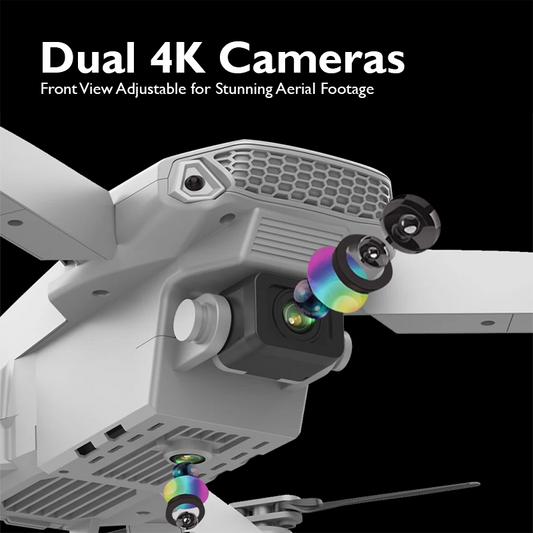The Role of Drones in Urban Wildlife Corridor Development

In today's rapidly urbanizing world, the need to preserve and protect natural habitats has become increasingly vital. Urban wildlife corridors serve as lifelines for various species, allowing them to move between fragmented habitats, find food, and seek shelter. However, amidst sprawling cities and expanding infrastructure, maintaining these corridors can be a daunting task. This is where drones are emerging as game-changers in the field of conservation and urban planning.
Understanding Urban Wildlife Corridors

Before delving into the role of drones, let's grasp the significance of urban wildlife corridors. These corridors are essentially pathways that connect fragmented patches of green spaces within urban areas. They enable the movement of wildlife, facilitating gene flow, migration, and the spread of seeds crucial for biodiversity conservation. Without these corridors, wildlife populations face isolation, leading to genetic stagnation and, ultimately, decline.
Challenges in Corridor Development
Creating and maintaining wildlife corridors amidst urban sprawl presents numerous challenges. Urbanization often results in habitat loss, fragmentation, pollution, and increased human-wildlife conflicts. Moreover, identifying suitable locations for corridors and monitoring their effectiveness requires extensive resources, time, and expertise. Traditional methods of surveying and mapping these areas are often labor-intensive, expensive, and may not provide real-time data.
Enter Drones: Aerial Solutions for Conservation

Drones, also known as unmanned aerial vehicles (UAVs), are revolutionizing how we approach wildlife corridor development and conservation. These versatile flying machines offer a myriad of benefits:
i. Aerial Surveys: Drones equipped with high-resolution cameras and sensors can efficiently survey vast areas of land, providing detailed aerial imagery and data. This aerial perspective allows conservationists and urban planners to identify potential corridors, assess habitat quality, and monitor changes over time.
ii. Remote Sensing: Advanced drone technology enables remote sensing capabilities, including infrared and thermal imaging. This enables researchers to detect wildlife presence, track movements, and identify habitat preferences without disturbing the animals. Such non-invasive monitoring is crucial for understanding wildlife behavior and informing corridor design.
iii. Cost-Effectiveness: Compared to traditional surveying methods, drones offer a cost-effective solution for corridor development and monitoring. They require fewer personnel, less time, and lower operational costs, making conservation efforts more efficient and scalable.
iv. Rapid Response: Drones provide real-time data collection and analysis, allowing for rapid response to environmental changes or emerging threats. This agility is particularly valuable in dynamic urban landscapes where habitat conditions may rapidly deteriorate due to urbanization, pollution, or natural disasters.
v. Public Engagement: Drones can also be used as educational tools to engage the public in conservation efforts. By capturing captivating aerial footage of wildlife corridors and sharing it through various media channels, drones help raise awareness about the importance of preserving urban biodiversity.
Case Studies: Drones in Action
Several successful initiatives around the world have demonstrated the efficacy of drones in urban wildlife corridor development:
a. Los Angeles, California

In one of the most densely populated cities in the United States, researchers are using drones to map and monitor wildlife corridors in the Santa Monica Mountains. By studying the movement patterns of mountain lions and other wildlife, they aim to enhance connectivity between fragmented habitats and reduce human-wildlife conflicts.
b. Singapore

Despite its limited land area, Singapore is committed to maintaining green spaces and biodiversity within its urban landscape. Drones are being employed to survey and monitor the island's network of nature reserves and park connectors, ensuring the continuity of wildlife habitats and ecological connectivity.
c. Berlin, Germany

The German capital is renowned for its green spaces and commitment to urban biodiversity. Drones are being utilized to survey and monitor wildlife corridors along the city's riverbanks, railway lines, and green belts. This data-driven approach informs urban planning decisions and helps conserve native species such as bats, birds, and amphibians.
Looking Ahead: Future Directions

As drone technology continues to evolve, so too will its applications in urban wildlife corridor development. Future advancements may include:
1. Autonomous Monitoring:
AI-powered drones capable of autonomous flight and data analysis will streamline corridor monitoring and management, reducing human intervention and operational costs.
2. Sensor Integration:
Integration of advanced sensors, such as LiDAR and multispectral cameras, will enhance the accuracy and depth of drone-based surveys, providing richer ecological insights.
3. Collaborative Platforms:
Collaborative platforms and data-sharing initiatives will facilitate knowledge exchange and collaboration among researchers, conservation organizations, and urban planners worldwide.
4. Policy Integration:
Incorporating drone technology into conservation policies and urban planning frameworks will ensure its sustainable and ethical use, balancing conservation objectives with societal needs.
In conclusion, drones are playing a pivotal role in shaping the future of urban wildlife corridor development. By harnessing the power of aerial technology, we can better understand, protect, and enhance these vital lifelines for wildlife in urban environments. As we navigate the challenges of urbanization and environmental degradation, drones offer a beacon of hope, enabling us to conserve biodiversity and create greener, more sustainable cities for generations to come.
Explore a variety of drones at our online drone store.Happy Flying!











